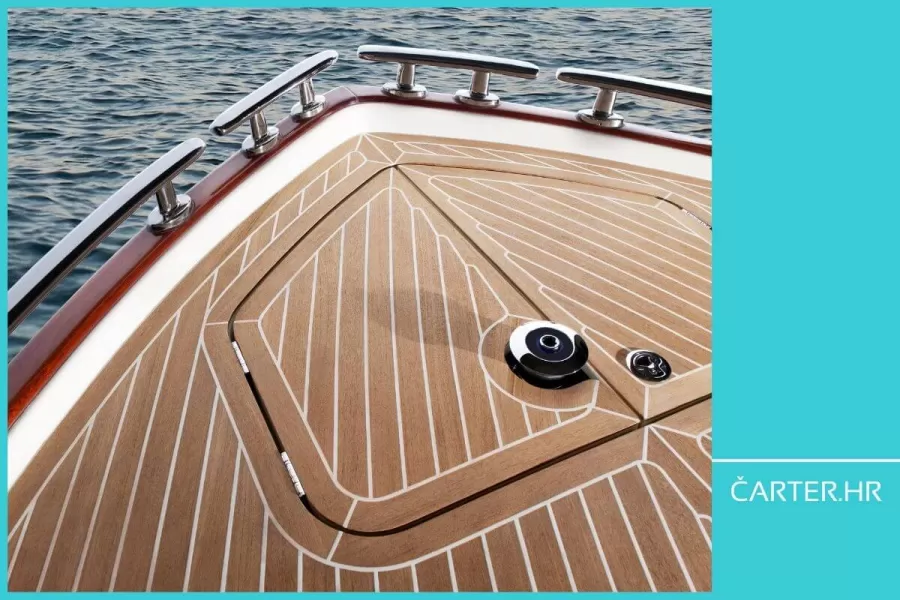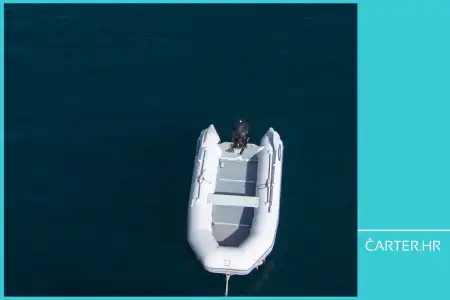
- 11.12.2023.
- News, Technology
Flooring for boats, such as teak, are a practically irreplaceable material for paneling the exterior surfaces of vessels. To preserve teak wood and its original appearance and shine requires additional investment is required. Artificial decking, such as artificial teak, is easy to install and maintain. Find out the advantages and disadvantages of the different types of boat decking.
Of course, it's perfectly fine to let teak fade over time. However, we do not recommend it for the luxurious look of the boats you rent to guests.
Fortunately, for those who choose not to invest in the regular maintenance of natural teak, there are many artificial floorings for boats available.
These types of decking do not require as much attention, and you will have almost the same feeling on the deck as if it were covered with teak.
We will outline the pros and cons so you can make the best decision for your vessels when it comes to marine decking.

Cork flooring for boats
In between genuine and faux teak are cork-based flooring such as Corkline.
This popular and adaptable flooring combines cork granules, rubber and special binders. This results in a technologically advanced product that you can use to cover exterior and interior decks. But also any other space exposed to moisture.
Cork flooring are an excellent alternative to teak because they are more affordable and do not require renewal every season.
They are solid and stable and prevent slipping. At the same time, they are elastic and resistant to natural disasters, damage, shocks and scratches. They have a very attractive appearance and are easy to install and maintain with standard cleaning products.
Although cork flooring are visually acceptable, their main drawback is the less aesthetically pleasing appearance of a deck made of real natural teak.

Artificial teak and its advantages
For this reason, teak is the most popular material used to cover the exteriors of yachts and other types of boats for rent. But its economy is increasingly questionable as it becomes rarer and more expensive.
There is a growing demand for teak on the market, which the supply simply cannot meet.
Therefore, in its place, we increasingly see products from different companies that can be reduced to the common denominator of "artificial teak".
Artificial teak has been surprisingly well received by boat owners in the last few years.
Many point out that it has specific, mostly practical, advantages compared to real natural teak and some of them are:
- Affordable price
- Resistance
- Simple maintenance
- Simple assembly
- Less weight
- Colourfastness
- Stability and comfort
Affordable price
Those who don't mind a budget will likely shell out as much as they need for the unique wood decking experience. For those who care about savings, the artificial teak price can influence the decision.
The final amount, of course, varies depending on your chosen manufacturer. Still, in general, the price of artificial teak is significantly lower than that of natural teak. Choosing artificial teak also means additional savings if you consider that you do not have to spend every season on maintenance.
Resistance
Artificial flooring are highly resistant to seawater, fuel, oils, petroleum, blood, and red wine, i.e. they do not absorb any liquid. They also repel UV radiation. They are elastic, pliable and not damaged by use, so even 8-10 years after installation, they look practically like new.
Simple maintenance
One of the most significant advantages of artificial teak over the real one, which the nautical industry emphasizes the most, is its simplicity and functionality in maintenance. After installation, there is almost no work around it. On the other hand, natural teak requires time, energy and money every season to keep it in good condition.
Simple assembly
Artificial teak is very easy to install. You can do this work independently without calling an expert if you have some knowledge. Ultimately, this brings additional savings. In addition, artificial teak is mostly glued, so the deck will not be damaged by screws, etc.
Less weight
Artificial teak is lighter than natural teak, and we know that every kilogram less on board brings savings on fuel!
Colourfastness
It is also known that over time, real teak, exceptionally when not adequately maintained, lightens and turns grey, losing its original colour and shine.
Artificial teak does not change colour; it remains permanently new and comes in many shades.
Imitation teak is usually almost perfect, and because of the different colours you choose, you can combine it nicely and adapt it to the vessel's design.
The artificial teak that comes in larger sizes is particularly interesting, so different unique shapes can be printed on them. This way, you also have other creative possibilities when arranging the vessel.
Stability and comfort
Specially treated artificial teak is an excellent surface for walking in wet conditions because it is stable and prevents slipping. It is softer than natural teak, making sitting and lying more comfortable. In addition, artificial teak can even be a sound insulator and reduce noise, which brings additional comfort while staying on the vessel.

Disadvantages of artificial flooring for boats
Artificial flooring such as artificial teak, have won many boat owners' hearts (and wallets) since their appearance on the market with various advantages.
However, there are certain shortcomings that sailors notice for which manufacturers have not yet found adequate solutions:
- Fast heating
- Lack of aesthetics
- Lack of natural smell
- Price non-competitiveness (in some cases)
Fast heating
Even though natural oil-treated teak warmed in the sun is not the most comfortable to walk barefoot, many people complain that artificial teak is excessively heated in the summer.
Others say that it heats up even less than the original teak and that you can walk undisturbed at any time of the day.
The consequences of sun exposure will depend on the type of artificial teak and the materials used in its production. It is best to investigate this issue from manufacturer to manufacturer.
Lack of aesthetics
Many boaters and owners say that faux boat decking simply cannot replace the look or feel of natural teak on the deck.
It is a reflection of style and sophistication, enriches the space it decorates, and each piece has its own original origin and shape.
Lack of natural smell
In addition to the lack of aesthetics, it is also mentioned that artificial teak simply cannot provide a unique atmosphere, such as the smell of natural wood that spreads through the deck.
Decades of patience were invested in natural teak until it grew, and hours and hours of love of the woodworker who processed it and installed it on the vessel. Making and installing teak is also a particular form of art.
Price non-competitiveness (in some cases)
The price of natural teak reflects its demand and limited supply. Teak is increasingly becoming one of the signs of luxury, which is why it is worth investing in it for many yacht charter boat owners.
And yet, some versions of artificial decking for boats are almost as expensive as actual teak.
Some manufacturers of artificial flooring ask for almost the same, and sometimes higher, amounts than the manufacturers of natural teak ask. But still, artificial flooring for boats do not have the same value or the same impression in terms of luxury.
As the nautical industry and the market develop, there are more and more different alternatives for boat flooring.
Both natural and artificial flooring have their unique advantages and disadvantages.
The final decision is up to you: which advantages sound enticing enough for your vessels, and which disadvantages are you willing to live with.
In the end, the only objective criterion when choosing should be your satisfaction and the satisfaction of your guests!
Categories of trends
- News
- Sale
- Marketing
- SEO
- Web design
- Social media
- Technology
- Regulations
- Management
- Education
- Finances
- User experience
Newsletter
Sign up for the newsletter and receive the latest trends and tips straight to your inbox



